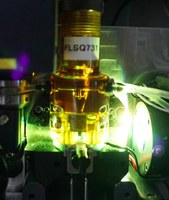Sample Preparation for Cell Sorting
Cell concentration
In order to be able to take advantage of the high speed of the cell sorter, samples should be fairly concentrated This is especially important for experiments where large numbers of cells are to be run.
Concentration for large samples should be between 2 and 5 x 107 cells/ml
This allows the cells to be sorted without having to apply excessive extra pressure to the sample tube in order to achieve a rate of 20 to 25,000 events per second. However, cells at lower concentrations can also be sorted without problem, for example when a relatively small number of cells is to be sorted.
The minimum starting volume for the sample to be sorted is 500 µL.
Sort Buffers
We recommend resuspending the sample in PBS containing 2% FCS, but for sensitive, clumpy or adherent cells you can try one of these sort buffers instead:
For Clean Lymphoid Cells:
The buffer can be simplified to HBSS with 1% FBS. The additional cations in the recipe promote better viability. Since these cells are not prone to clump, the lack of EDTA is not a problem.
For Sticky Cells:
Raise the concentration of the EDTA to 5mM and use FBS that has been dialyzed against Ca/Mg++ free PBS. Some activated cells become clumpy and the chelators (EDTA) help reduce cation-dependent cell-to-cell adhesion.
For Adherent Cells:
In order to achieve good single cell preparations, one must start at the moment of detaching your cells from the plate. Typically, the trypsin (or other detachment buffer) is quenched with culture media or a PBS/FCS buffer. This is problematic because it reintroduces the cations that facilitate the cells reattaching to the plate (or each other). It is necessary to use a cation-free FCS buffer in order to stop the detachment. In addition, the level of EDTA can be increased if necessary (although too much EDTA can be harmful).
For Samples with a High Percentage of Dead Cells:
If there are a large number of dead cells in the prep, it is likely that there is soluble DNA from the dead cells that will come out of solution. This DNA will start to coat the cells and lead to severe clumping. The addition of 10U/mL DNAase II to the buffer recipe will help reduce DNA-associated clumpiness.
Collection Buffers:
We recommend collecting cells into pure FCS, PBS containing FCS, or one of the above-mentioned sort buffers, especially when large volumes of cells will be sorted. The reason for this is because phosphate-buffered medium (i.e. sheath fluid) can cause precipitation of salts when mixed with carbonate-buffered medium (RPMI, MEM, etc.) potentially leading to viability problems in sensitive cells.
For cells which are to grow under serum-free conditions, serum-free media can be used, with the collection tubes simply changed more frequently. For rare cells, the volume of the sorted cells won't be large enough to cause precipitation, and therefore it is also fine to use standard media with serum.
Cell straining / filtering
In order to minimize the possiblity of nozzle clogs, the cell sample must be put through a 40 micron cell strainer before sorting (for example: Falcon cat. no. 2340). After filtering, the cells should be kept on ice and protected from light. For really sticky cells, it may be necessary to filter them again just prior to sorting because they can clump when sitting for longer periods of time.
Biosafety
The Lighthouse cell sorting service is classified to a Biosafety Level of 2. Therefore only cells of risk groups 1 and 2 can be sorted. During the sort aerosols can arise. Therefore it is necessary to determine the risk potential of the cells prior to sorting to take appropriate precautions.
For this reason, please fill out the following form:
Note:
It is not necessary to fill out the biosafety form for each individual Sort. However, it must be filled out for each different cell type, treatment and origin of the cells.


